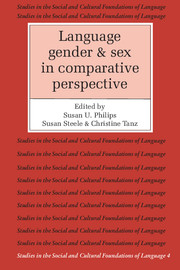Book contents
- Frontmatter
- Contents
- Acknowledgments
- List of contributors
- Introduction: The interaction of social and biological processes in women's and men's speech
- Part I Women's and men's speech in cross-cultural perspective
- Part II Gender differences in the language of children
- Part III Sex differences in language and the brain
- Introduction
- 10 Cerebral organization and sex: interesting but complex
- 11 Sex differences in the patterns of scalp-recorded electrophysiological activity in infancy: possible implications for language development
- References
- Index
10 - Cerebral organization and sex: interesting but complex
Published online by Cambridge University Press: 05 June 2012
- Frontmatter
- Contents
- Acknowledgments
- List of contributors
- Introduction: The interaction of social and biological processes in women's and men's speech
- Part I Women's and men's speech in cross-cultural perspective
- Part II Gender differences in the language of children
- Part III Sex differences in language and the brain
- Introduction
- 10 Cerebral organization and sex: interesting but complex
- 11 Sex differences in the patterns of scalp-recorded electrophysiological activity in infancy: possible implications for language development
- References
- Index
Summary
With the increased interest in hemispheric specialization of function that has evolved since the end of the 1960s, a number of hypotheses have been put forward regarding the “strictness” or “degree” of hemispheric specialization as a function of subject, or person, characteristics. Among the characteristics that have been suggested as influencing the degree of hemispheric specialization are handedness, familial left-handedness, handwriting posture, and, most relevantly, sex. With respect to sex differences, Levy (1969), McGlone (1978, 1980), and Waber (1976) have all suggested that females may be less hemispherically specialized for language and spatial processing than males.
According to Levy (1969), the hemispheric organization favorable for conjointly optimizing verbal and spatial abilities is one of very strict lateralization of language functions to the left cerebral hemisphere and of spatial functions to the right hemisphere. Levy hypothesizes that when language is relatively bilateralized, that is, when some aspects or types of language function are partially or wholly mediated by the right hemisphere, language skills may be augmented, but spatial ability will be correspondingly diminished. The assumption is that while the right hemisphere is sometimes capable of some language functions, the left hemisphere is unable to compensate for reduced right-hemisphere spatial competence. Since there are data showing females to be superior to males in at least some aspects of language ability and showing males to be superior to females in visual-spatial abilities (Maccoby and Jacklin, 1974), the hypothesis that females are more bilateralized for language accords well with the pattern of consequences for ability that Levy (1969) predicts.
- Type
- Chapter
- Information
- Language, Gender, and Sex in Comparative Perspective , pp. 268 - 277Publisher: Cambridge University PressPrint publication year: 1987
- 2
- Cited by

